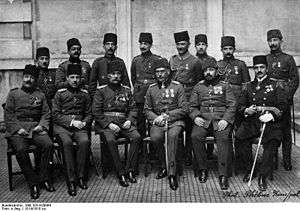Fifth Army (Ottoman Empire)
| Fifth Army | |
|---|---|
|
Headquarters Personnel: front row, from right to left: Hüseyin Rauf Bey, Vehib Pasha, Sanders Pasha, Esat Pasha, Süleyman Pasha, Cevat Bey ?, back row, from right to left: İsmet Bey, (from Second Army), Âsım Bey, Perike, Kâzım Bey, Şükrü Bey (from First Army), Refik Münir Bey (from Second Army) | |
| Active | March 25, 1915 – November 21, 1918[1] |
| Country | Ottoman Empire |
| Type | Field Army |
| Engagements | Gallipoli Campaign (World War I) |
| Commanders | |
| Notable commanders |
Otto Liman von Sanders (March 1915–24 February 1918) |
The Fifth Army of the Ottoman Empire or Turkish Fifth Army was formed on March 24, 1915 and dissolved on October 1918. It was assigned the responsibility of defending the Dardanelles straits in World War I. The original commander of the army was the German military advisor to the Ottoman Empire, General Otto Liman von Sanders. The command passed to Vehip Pasha who became responsible for the Helles front while von Sanders still wielded considerable influence.
Order of Battle, April 1915
In Late April 1915, the army was structured as follows:[2]
- III Corps (commanded by Esat Pasha)
- 7th Division, 9th Division, 19th Division (commanded by Mustafa Kemal Atatürk)
- XV Corps (commanded by Colonel Hans Kannengiesser)
- 3rd Division, 11th Division
- Dardanelles Fortified Area Command
- One aircraft squadron
When the Allied campaign the Battle of Gallipoli, which aimed to seize the Dardanelles, commenced, the Fifth Army comprised two army Corps; the III Corps was defending the Gallipoli peninsula and the XV Corps was defending the Asian shore. The XV. Corps, also known as the "Asian Group." In addition, the 5th Division was positioned north of the peninsula under the command of First Army.
World War I
Order of Battle, Late Summer 1915

The number of divisions involved in the defence of the peninsula expanded to ten and an unattached infantry regiment and a brigade of cavalry before the August Offensive. In Late Summer 1915, the army was structured as follows:[3]
- I Corps
- 2nd Division, 3rd Division
- II Corps
- 4th Division, 5th Division, 6th Division
- III Corps
- 7th Division, 8th Division, 9th Division, 19th Division
- IV Corps
- 10th Division, 11th Division, 12th Division
- V Corps
- 13th Division, 14th Division, 15th Division
- Dardanelles Fortified Area Command
- One aircraft squadron
A further three divisions arranged in the "Asian Group." The four divisions at Anzac made up the III Corps. (6 at Helles, 4 at Anzac) plus additional.
Order of Battle, August 1916
In August 1916, the army was structured as follows:[4]
- I Corps
- 14th Division, 16th Division
- Dardanelles Fortified Area Command
Order of Battle, December 1916
In December 1916, the army was structured as follows:[5]
- XIV Corps
- 57th Division, 59th Division
- Dardanelles Fortified Area Command
Order of Battle, August 1917, January 1918
In August 1917, January 1918, the army was structured as follows:[6]
- XIV Corps
- 57th Division
- XIX Corps
- 59th Division
- XXI Corps
- 49th Division
- Dardanelles Fortified Area Command
Order of Battle, June, September 1918
In June, September 1918, the army was structured as follows:[7]
- XIV Corps
- 57th Division
- XIX Corps
- None
- XXI Corps
- 49th Division
- Dardanelles Fortified Area Command
After Mudros
Order of Battle, November 1918
In November 1918, the army was structured as follows:[8]
Sources
- ↑ David Nicolle, colour plates by Rafaelle Ruggeri, The Ottoman Army 1914–18, Men-at-Arms 269, Ospray Publishing Ltd., 1994, ISBN 1-85532-412-1, p. 15.
- ↑ Edward J. Erickson, Order to Die: A History of the Ottoman Army in the First World War, Greenwood Press, 2001, ISBN 0-313-31516-7, p. 86.
- ↑ Edward J. Erickson, Order to Die: A History of the Ottoman Army in the First World War, Greenwood Press, 2001, ISBN 0-313-31516-7, p. 109.
- ↑ Edward J. Erickson, Order to Die: A History of the Ottoman Army in the First World War, Greenwood Press, 2001, ISBN 0-313-31516-7, p. 134.
- ↑ Edward J. Erickson, Order to Die: A History of the Ottoman Army in the First World War, Greenwood Press, 2001, ISBN 0-313-31516-7, p. 154.
- ↑ Edward J. Erickson, Order to Die: A History of the Ottoman Army in the First World War, Greenwood Press, 2001, ISBN 0-313-31516-7, p. 170, 181.
- ↑ Edward J. Erickson, Order to Die: A History of the Ottoman Army in the First World War, Greenwood Press, 2001, ISBN 0-313-31516-7, p. 188, 197.
- ↑ Edward J. Erickson, Order to Die: A History of the Ottoman Army in the First World War, Greenwood Press, 2001, ISBN 0-313-31516-7, p. 202.
